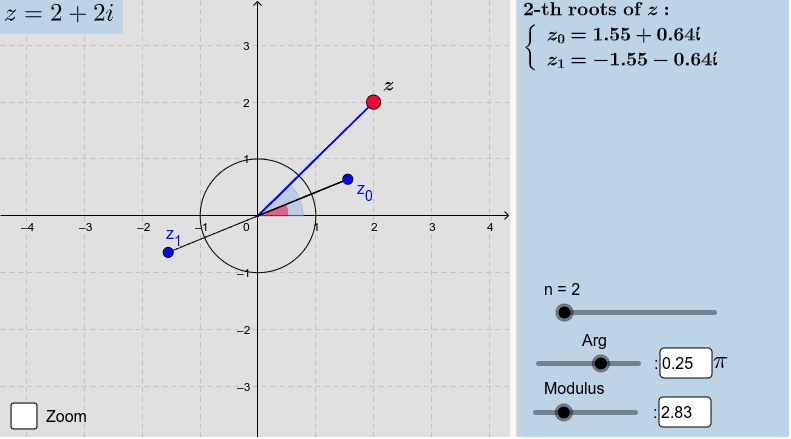1.5: Roots of Complex Numbers
( \newcommand{\kernel}{\mathrm{null}\,}\)
Recall that if z=x+iy is a nonzero complex number, then it can be written in polar form as
z=r(cosθ+isinθ)
where r=√x2+y2 and θ is the angle, in radians, from the positive x-axis to the ray connecting the origin to the point z.
Now, de Moivre’s formula establishes that if z=r(cosθ+isinθ) and n is a positive integer, then
zn=rn(cosnθ+isinnθ)
Let w be a complex number. Using de Moivre’s formula will help us to solve the equation
zn=w
for z when w is given.
Suppose that w=r(cosθ+isinθ) and z=ρ(cosψ+isinψ) Then de Moivre’s formula gives
zn=ρn(cosnψ+isinnψ)
It follows that
ρn=r=|w|
by uniqueness of the polar representation and
nΨ=θ+k(2π),
where k is some integer. Thus
z=n√r[cos(θn+2kπn)+isin(θn+2kπn)].
Each value of k=0,1,2,…,n−1 gives a different value of z. Any other value of k merely repeats one of the values of z corresponding to k=0,1,2,…,n−1. Thus there are exactly nth roots of a nonzero complex number.
Using Euler’s formula:
eiθ=cosθ+isinθ,
the complex number \(z=r(cos\theta +isin\theta) \\) can also be written in exponential form as
z=reiθ
Thus, the nth roots of a nonzero complex number z≠0 can also be expressed as
z=n√rexp[i(θn+2kπn)]
where k=0,1,2,...,n−1.
The applet below shows a geometrical representation of the nth roots of a complex number, up to n=10. Drag the red point around to change the value of z or drag the sliders.

- Code
-
Enter the following script in GeoGebra to explore it yourself and make your own version. The symbol # indicates comments.
#Complex number Z = 1 + ί #Modulus of Z r = abs(Z) #Angle of Z theta = atan2(y(Z), x(Z)) #Number of roots n = Slider(2, 10, 1, 1, 150, false, true, false, false) #Plot n-roots nRoots = Sequence(r^(1 / n) * exp( ί * ( theta / n + 2 * pi * k / n ) ), k, 0, n-1)
Exercise 1.5.1
From the exponential form (1) of the roots, show that all the nth roots lie on the circle |z|=n√r about the origin and are equally spaced every 2πn radians, starting with argument θn.


